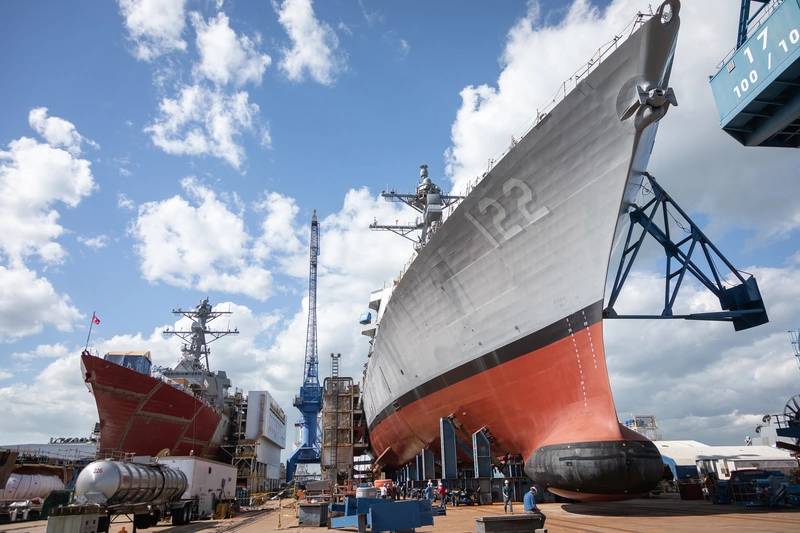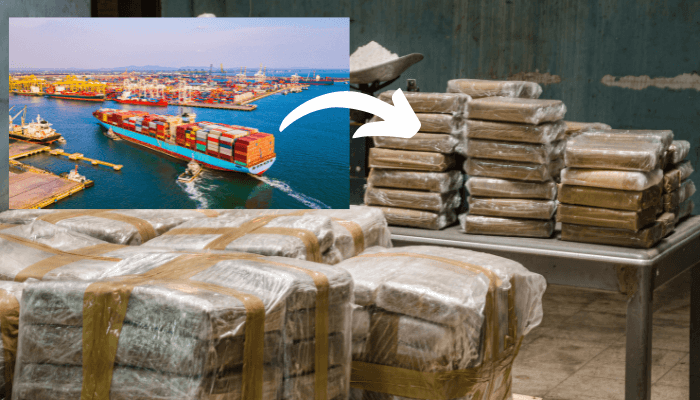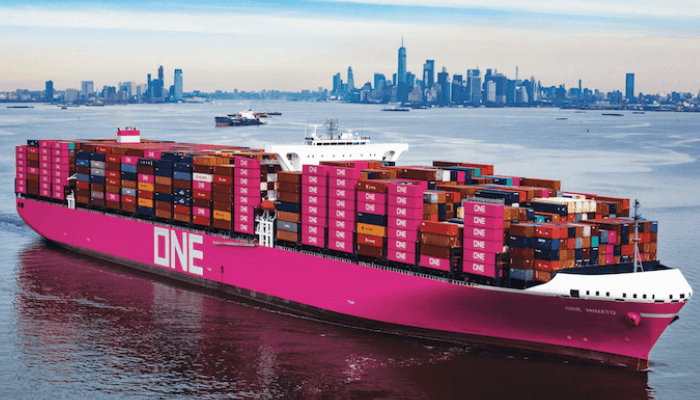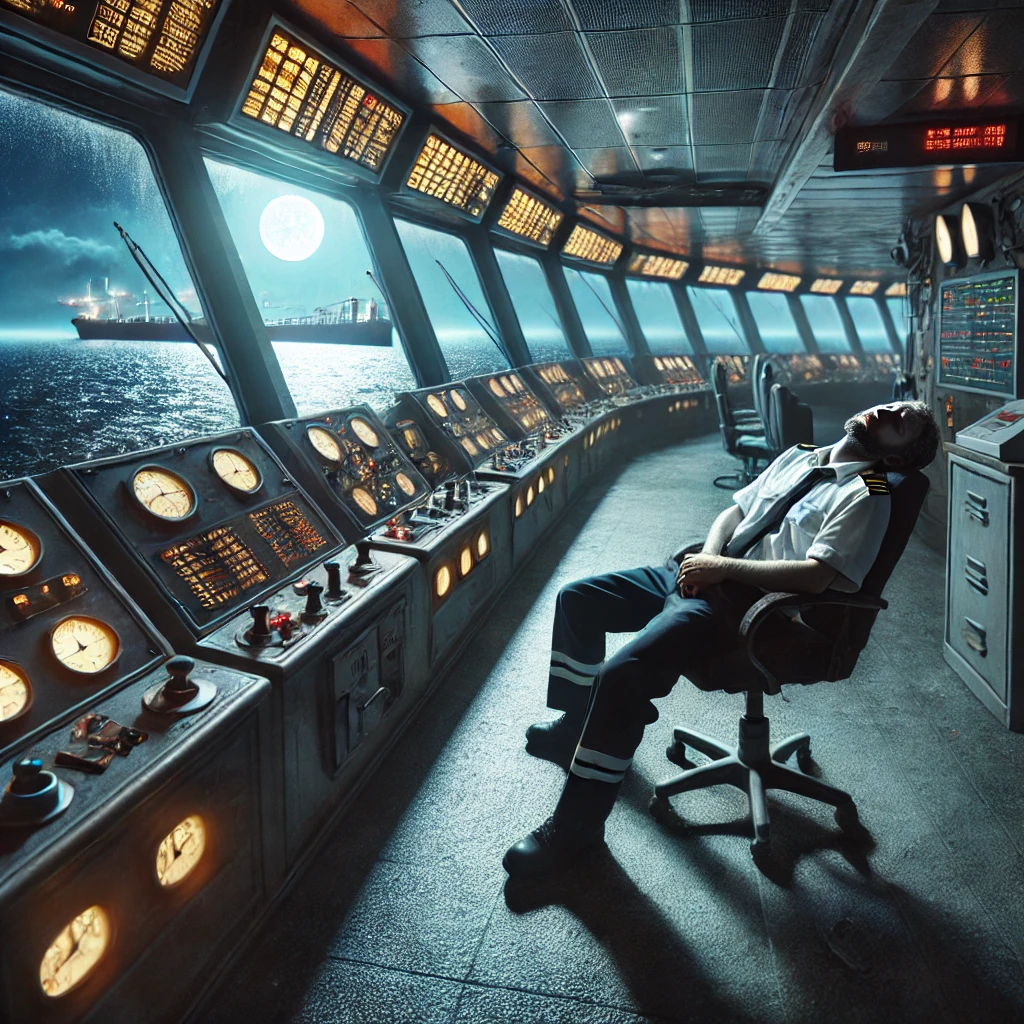U.S. shipyards are making improvements to building ships for the Navy and Coast Guard today and in the future. In some cases, it means phasing out one class of ship and getting ready for the next. Or, it can be a drastic make-over.
The yards include mid-tier yards all the way up to very large facilities devoted exclusively to warships. The ships range from the 353-ton Fast Response Cutter to the 100,000-ton nuclear-powered aircraft carriers.
Fincantieri Marinette Marine in Wisconsin is transitioning from its Freedom-class littoral combat ship production line to building the new Constellation-class of guided missile frigates. In the interim, FMM is also completing four multi-mission surface combatants, based on the Freedom-class design, for the Royal Saudi Navy.
Bollinger Shipyards of Lockport, La., delivered the 154-foot Legend-class Fast Response Cutter (FRC) USCGC Douglas Denman to the U.S. Coast Guard in May. Douglas Denman is the 49th Fast Response Cutter (FRC) delivered under the current program of 64 cutters—and Congress has appropriated funds for two additional FRCs beyond the 64.
Austal USA’s all-aluminum parallel production lines that are producing littoral combat ships and expeditionary fast transports have been augmented with a steel production capability. Since October of 2021 Austal USA received contracts to build two steel towing, salvage and rescue tugs, with a contract for two more issued on July 22), with construction of the first starting on July 11. Austal USA also received a contract to build an auxiliary floating drydock for the Navy. But the investment really paid off when the Mobile-Ala., yard won the competition for phase II of the Coast Guard Offshore Patrol Cutter (OPC). This will provide up to 11 of the 360-foot 4,500-ton cutters.
Eastern Shipbuilding Group (ESG) of Panama City, Fla., was the original OPC prime contractor. Although they were expected to build the first ten OPCs, ESG’s shipbuilding facilities were damaged following Hurricane Michael in October of 2018. The shipyard submitted a request for extraordinary relief to help the facility recover and the people return to work. Subsequently, relief was granted, but limited to the first four hulls in the OPC program. The Coast Guard announced that the OPC program would be restructured to include a competition for a new contract to build subsequent OPCs. That award went to Austal USA.
Huntington Ingalls Industries is constructing the 1,092-foot, 100,000-ton Gerald R. Ford-class aircraft carriers and Virginia-class attack submarines at its Newport News Ship Yard (NNSY) in Virginia.
The first, USS Gerald R. Ford (CVN 78), was commissioned in 2017. The next three—Precommissioning Unit (PCU) John F. Kennedy (CVN 79), PCU Enterprise (CVN 80) and PCU Doris Miller (CVN 81), are building. NNSY is also building Virginia-class attack submarines.
 The future USS John Basilone (DDG 122) undergoes “translation” from Land Level to the Kennebec River at General Dynamics Bath Iron Works in Maine. During its translation into the dry dock, the ship was wheeled at a rate of 6 feet per minute via the rail system embedded in the Land Level Transfer Facility. (BIW Photo)
The future USS John Basilone (DDG 122) undergoes “translation” from Land Level to the Kennebec River at General Dynamics Bath Iron Works in Maine. During its translation into the dry dock, the ship was wheeled at a rate of 6 feet per minute via the rail system embedded in the Land Level Transfer Facility. (BIW Photo)
Submarines
General Dynamics Electric Boat (EB) Electric Boat and NNSY are building the Virginia class fast attack submarines (SSNs) in a teaming arrangement with Newport News Shipbuilding. “We build different portions of each ship and alternate final assembly at our respective yards,” said EB spokesman Daniel McFadden.
The sail, stern, bow, habitability, machinery spaces, and torpedo room are assembled at NNSY, while EB’s Groton, Conn., and Quonset Point, R.I. facilities are building the engine room and control room. The shipyards take turns building the reactor plant and the final assembly, outfitting and delivery.
“Currently there are 13 ships in various stages of production. The next delivery from Electric Boat will be the Hyman G. Rickover (SSN 795),” McFadden said.
The Virginia-class construction has progressed in blocks, with the boats having successively more capability or built with more efficiency. The Block III submarines were being built with a pair of multipurpose Virginia Payload Tubes (VPT), which replaced the single purpose cruise missile launch tubes. Block V variants are longer so they can incorporate the new Virginia Payload Module (VPM).
The lead ship, USS Virginia (SSN 774), was commissioned in 2004. The newest, USS Montana (SSN 794), was commissioned in June of this year. Sixteen more are under construction or authorized, divided between the two yards.
The Navy plans to build 12 Columbia (SSBN-826) class ballistic missile submarines (SSBNs) to replace the Navy’s current force of 14 aging Ohio-class SSBNs. While both NNSY and EB are expected to build the new subs, EB is the primary contractor and all boats will be assembled, tested, launched, and delivered at Groton.
General Dynamics has invested $1.85 billion in infrastructure improvements and expansion at Electric Boat to support the Columbia class production. “This involves new buildings and tooling for hull module construction at its Quonset Point, Rhode Island, facility, a 200,000 square-foot assembly building at the Groton, Connecticut, shipyard, a custom transport barge for the Columbia modules, and a floating dry dock now under construction by Bollinger Shipyards,” McFadden said.
HII’s Ingalls Shipbuilding division is building National Security Cutters for the Coast Guard, Arleigh Burke-class guided missile destroyers, and San Antonio Class amphibious ships and America-class assault ships in Pascagoula, Miss. That includes the 844-foot, 45,000-ton future USS Bougainville (LHA 8), as well as three San Antonio-class amphibious transport dock ships (LPDs). The yard is transitioning from the Flight I LPD to Flight II, with the new variant being a slightly less capable variant and more affordable to replace the Navy’s 12 aging Whidbey Island/Harpers Ferry (LSD-41/49) class landing ship dock (LSD) ships. Richard M. McCool (LPD 29) is the final Flight I LPD, while Harrisburg (LPD 30) will be the first Flight II. Both are under construction, soon to be joined by Pittsburgh (LPD 31)
Ingalls has delivered nine Legend-class national security cutters to the Coast Guard. The 10th, USCGC Calhoun (WMSL 759) was christened in June and scheduled to be delivered early next year. Ingalls is the sole yard building the NSC, LPD and LHA.
Ingalls is also one of two shipyards building Arleigh Burke-class guided missile destroyers (DDGs). According to a news release, “Frank E. Petersen Jr. is the 33rd destroyer Ingalls has built for the U.S. Navy, with five more currently under construction at Ingalls, including Lenah Sutcliffe Higbee (DDG 123), Jack H. Lucas (DDG 125), Ted Stevens (DDG 128), Jeremiah Denton (DDG 129) and George M. Neal (DDG 131).”
Jack Lucas is the first of the new Flight III DDGs, incorporating a new and more capable SPY-6 Air and Missile Defense Radar (AMDR).
General Dynamic’s NASSCO yard in San Diego is continuing to build the John Lewis-class of fleet oilers (T-AOs) and Lewis B. Puller-class of Expeditionary Mobile Bases (ESBs).
The 50,000-ton, 746-foot John Lewis-class of class of fleet replenishment oilers will eventually comprise twenty ships and will replace the Henry J. Kaiser-class replenishment oilers now in service.
- USNS John Lewis (T-AO 205) – delivering this year
- USNS Harvey Milk (T-AO 206) – launch and christened on 11/06/2021
- USNS Earl Warren (T-AO 207) – christening and launch scheduled for later this year
- USNS Robert F. Kennedy (T-AO 208) – under construction
- USNS Lucy Stone (T-AO 209) – under contract
- USNS Sojourner Truth (T-AO 210) – under contract
- John L. Canley (ESB 6) – christened June 2022
- Robert E. Simanek (ESB 7) – under construction
NASSCO spokesman Brian Jones said the company is making the San Diego yard more productive, efficient and competitive.
“We’ve invested in more automated production equipment and modern welding technology like our Thin Plate Panel Line. The cutting-edge facility uses hybrid laser arc welding and numerically controlled robots to mill, seam and weld steel panels in a highly automated production line. These features improve capacity, quality, accuracy, cycle time and produce lighter, more energy efficient ships. In addition, upgrading our blast equipment and smaller accuracy control tools have enhanced our shipbuilding process with less demand on our workforce,” Jones said.
General Dynamics Bath Iron Works spokesperson Julie Rabinowitz said her yard has 10 ships in its backlog, including the last of the Flight IIA ships and the newer Flight III variants. “Currently, seven ships are under construction. DDG 122 John Basilone was translated and christened in June, and all backlog ships have been funded by Congress.
- Flight IIA: Carl M. Levin (DDG 120) – John Basilone (DDG 122),– Harvey C. Barnum Jr. (DDG 124), and Patrick Gallagher (DDG 127).
- Flight III: Louis H. Wilson Jr. (DDG 126), William Charette) (DDG 130), Quentin Walsh) (DDG 132), John E. Kilmer (DDG 134) – Richard Lugar (DDG 136) – and J. William Middendorf (DDG 138).
According to Navy officials, the service is committed to a smooth and successful transition from DDG 51 to DDG(X) starting around FY 2030. The transition will preserve the critical shipbuilding and supplier industrial base by executing a collaborative design process with current DDG 51 shipyards and transitioning to a proven limited competition model between these shipyards at the right point in ship construction. Both Ingalls and BIW are expected to build DDG(X).
Source: https://www.marinelink.com/news/shipyards-adapt-help-navy-coast-guard-498583








